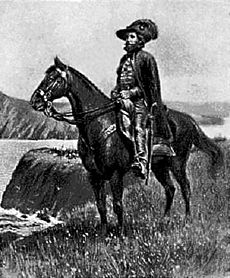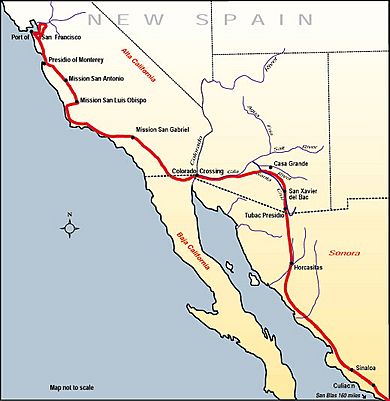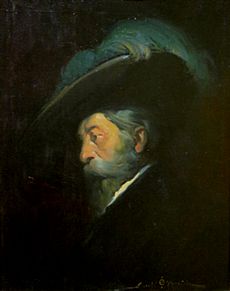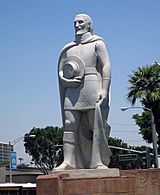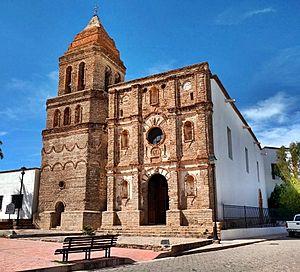Juan Bautista de Anza facts for kids
Quick facts for kids
Juan Bautista de Anza
|
|
|---|---|
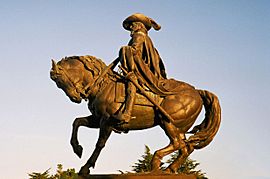
|
|
| 55th Governor of Province of New Mexico | |
| In office 1778–1788 |
|
| Preceded by | Francisco Trevre |
| Succeeded by | Fernando de la Concha |
| Personal details | |
| Born |
Juan Bautista de Anza Bezerra Nieto
July 6/7, 1736 Fronteras, New Navarre, Viceroyalty of New Spain (now Sonora, Mexico) |
| Died | December 19, 1788 Arizpe, New Navarre, New Spain |
| Profession | Explorer and Governor of New Mexico |
| Signature | |
Juan Bautista de Anza (born July 6 or 7, 1736 – died December 19, 1788) was an important Spanish explorer and leader. He was born in a Spanish province called New Navarre, which was part of a larger area known as New Spain (today, this area is in Mexico).
Juan Bautista de Anza came from a family with roots in the Basque region of Spain. He became a skilled explorer, a military officer, and a politician. He spent most of his career working for the Spanish Empire in areas that are now California and New Mexico. Many people consider him one of the founders of Spanish California. He also served as the Governor of the Province of New Mexico.
Contents
Anza's Early Life and Military Career
Juan Bautista de Anza Bezerra Nieto was born in 1736 in a place called Fronteras, which was then part of New Navarre, New Spain. Today, this area is in Sonora, Mexico. He was likely born near Arizpe, possibly at a military fort called the Presidio of Fronteras.
His family had a strong military background. Both his father, Juan Bautista de Anza I, and his grandfather were military leaders who served Spain. In 1752, when he was about 16, Anza joined the army at the Presidio of Fronteras. He quickly rose through the ranks and became a captain by 1760.
In 1761, he married Ana María Pérez Serrano. They did not have any children. Anza's main military duties involved leading missions against Native American groups, like the Apache, who were defending their lands. During these missions, he explored a large part of what is now Arizona.
Exploring and Settling California
Spain began to settle Alta California in 1769. The first efforts were difficult, involving long sea voyages and tough land journeys. Spanish settlements were set up in places like San Diego and Monterey. Each settlement had a military fort (called a presidio) and a mission run by Franciscan priests.
Anza wanted to find an easier land route to Alta California. In 1772, he suggested an expedition to the Viceroy of New Spain, who was like a governor representing the King of Spain. The King approved his plan.
On January 8, 1774, Anza began his first expedition from Tubac Presidio (south of modern-day Tucson, Arizona). He traveled with three priests, 20 soldiers, 11 servants, and many animals. He found a Native American guide named Sebastian Tarabal, who had traveled from Mission San Gabriel Arcángel to Sonora.
Anza's group took a southern path, crossing the Colorado River where it met the Gila River. This area was home to the Yuma tribe, and Anza managed to build good relationships with them.
He reached Mission San Gabriel Arcángel in California on March 22, 1774, and then Monterey, California, the capital of Alta California, on April 19. He returned to Tubac by May 1774.
The King of Spain was very interested in Anza's success. On October 2, 1774, Anza was promoted to lieutenant-colonel. He was ordered to lead a larger group of settlers to Alta California. Spain wanted to strengthen its presence there, partly to protect against Russian explorers moving south from the north.
The second expedition started on October 23, 1775. The journey was very hard due to winter weather. They arrived at Mission San Gabriel Arcángel in January 1776.
Anza then continued to Monterey, California with the settlers. After completing his main mission, he traveled north with Father Pedro Font and 12 others. They followed an inland route to the San Francisco Bay. On March 28, 1776, Anza found the perfect spots for the Presidio of San Francisco (a military fort) and Mission San Francisco de Asis in what is now San Francisco. He didn't build the settlements himself; that was done later by José Joaquín Moraga.
On his way back to Monterey, he also found the original locations for Mission Santa Clara de Asis and the town of San José de Guadalupe (modern-day San Jose, California). Today, the path he took is known as the Juan Bautista de Anza National Historic Trail.
However, Spain's dream of a permanent land route from Sonora to Alta California ended in 1781. The Yuma tribe rebelled and closed the trail at the Yuma Crossing of the Colorado River. The route stayed closed for many years, and most travel to Alta California after that was by sea.
Governor of New Mexico
After his successful expeditions, Anza traveled to Mexico City in 1777. There, he met with the chief of the Quechan (Yuma) Native American tribe, who asked for a mission to be built in their area.
On August 24, 1777, the Viceroy of New Spain appointed Anza as the Governor of the Province of Nuevo México, which is now the U.S. state of New Mexico.
As governor, Anza led a military campaign against the Comanche Native Americans in 1779. The Comanche had been raiding Taos repeatedly. Anza gathered his Ute and Apache Native American allies, along with about 800 Spanish soldiers. They traveled north through the San Luis Valley and entered the Great Plains near what is now Manitou Springs, Colorado.
Anza surprised a small group of Comanche near Colorado Springs. He chased them south and found the main Comanche force near Greenhorn Creek. They were returning from a raid in New Mexico. Anza won a major victory, and many Comanche leaders, including Chief Cuerno Verde, were killed. Greenhorn Creek is named after him.
In late 1779, Anza and his group found a new route from Santa Fe to Sonora, west of the main road called El Camino Real de Tierra Adentro. Anza's military actions against tribes defending their lands were often successful. However, the Quechan (Yuma) tribe, with whom he had made peace earlier, rebelled. This caused him to lose favor with the military commander of the Northern Frontier.
In 1783, Anza led another campaign against the Comanche on the eastern plains. By 1784, the Comanche were ready for peace. The last Comanche chiefs agreed to a formal treaty on February 28, 1786, at Pecos Pueblo. This treaty helped open the way for traders and the development of the Comanchero trade.
Juan Bautista de Anza remained governor of New Mexico until 1787. He then returned to Sonora. In 1788, he was appointed commander of the Presidio of Tucson, a military fort. However, he died before he could take office. He was 52 years old. Anza was survived by his wife.
Juan Bautista de Anza was buried in the Church of Nuestra Señora de la Asunción de Arizpe in Arizpe, Sonora, Mexico. In 1963, his remains were moved and reburied in a new marble memorial at the same church.
Anza's Legacy
Juan Bautista de Anza's most important legacy is the Juan Bautista de Anza National Historic Trail. This trail runs through California and Arizona. It is managed by the U.S. National Park Service and allows people to hike or drive parts of his historic expedition route.
Many places are named after Anza. These include:
- Anza-Borrego Desert State Park in eastern San Diego County, California.
- The de Anza Country Club in Borrego Springs, California.
- The Juan de Anza House in San Juan Bautista, California, which is a National Historic Landmark.
- The "Juan Bautista de Anza Community Park" in Calabasas, California.
- "De Anza Park" in Ontario.
- A 20-foot (6.1 m) statue of Anza in Riverside, California.
- Another statue in Lake Merced park, San Francisco.
- De Anza Boulevards in San Mateo and Cupertino.
- De Anza Park in Sunnyvale.
- De Anza College in Cupertino.
- De Anza High School in Richmond.
- Juan De Anza K-5 in Hawthorne.
- De Anza Middle School in Ontario and Ventura.
- De Anza Elementary School in El Centro.
- The De Anza School in Baldwin Park.
- The historic De Anza Hotel in San Jose and Calexico.
Places named using just "Anza" include:
- Anza Vista Avenue in the Anza Vista neighborhood of San Francisco.
- Anza Street in San Francisco's Richmond District.
- Lake Anza in Tilden Regional Park above Berkeley.
- The town of Anza, California, a small town of 7,000 people.
- Juan Bautista Circle in the Parkmerced development in San Francisco.
Images for kids
-
Equestrian statue of Anza at Lake Merced, San Francisco, California.
See also
 In Spanish: Juan Bautista de Anza para niños
In Spanish: Juan Bautista de Anza para niños


